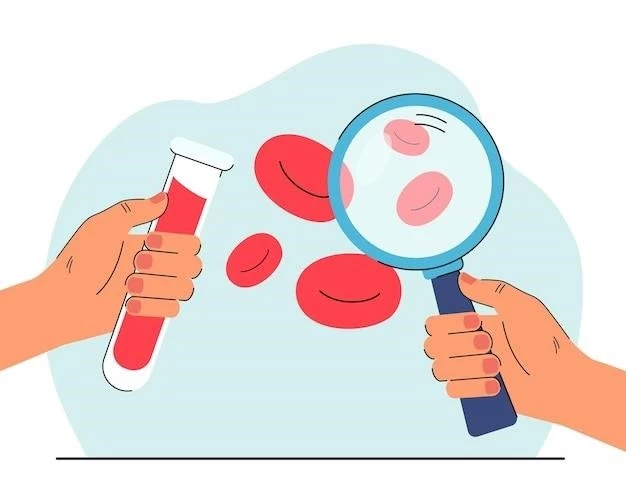Plan⁚ Understanding Platelet Disorders
Low platelet count can be caused by conditions such as autoimmune diseases or certain medications. Platelet disorders range from inherited conditions to acquired diseases; Treatment options for thrombocytopenia include medication, platelet transfusions, and lifestyle changes. Managing platelet disorders during pregnancy requires close monitoring by healthcare providers. Platelet transfusions are crucial in certain medical situations. Recognizing signs and symptoms of platelet dysfunction is essential for timely intervention. Natural remedies like a balanced diet can help increase platelet count. Platelets play a vital role in blood clotting to prevent excessive bleeding.
Causes of Low Platelet Count
Low platelet count, known as thrombocytopenia, can be caused by various factors. Some common causes include⁚
- Autoimmune disorders⁚ Conditions where the immune system attacks platelets.
- Infection⁚ Viral infections like HIV or bacterial infections can decrease platelet production.
- Medications⁚ Certain drugs, like chemotherapy or antibiotics, can lower platelet counts.
- Cancer⁚ Some cancers or cancer treatments can affect bone marrow, reducing platelet production.
- Pregnancy⁚ Gestational thrombocytopenia can occur due to increased blood volume during pregnancy.
- Genetic factors⁚ Inherited disorders like Wiskott-Aldrich syndrome can lead to low platelet counts.
Understanding the underlying cause of low platelet count is essential for proper diagnosis and management of thrombocytopenia.
Types of Platelet Disorders
Platelet disorders encompass a variety of conditions that affect platelet function and count. Some common types include⁚
- Immune Thrombocytopenia (ITP)⁚ Occurs when the immune system mistakenly attacks and destroys platelets.
- Thrombotic Thrombocytopenic Purpura (TTP)⁚ Characterized by blood clots forming in small blood vessels.
- Bernard-Soulier Syndrome⁚ A rare inherited disorder that affects platelet adhesion.
- Glanzmann Thrombasthenia⁚ Another rare inherited disorder resulting in defective platelet aggregation.
- May-Hegglin Anomaly⁚ Inherited disorder where platelets have abnormal structure and function.
- Essential Thrombocythemia (ET)⁚ Involves the overproduction of platelets, leading to increased risk of clotting.
- Thrombocytopathy⁚ General term for platelet function abnormalities that may result in bleeding or clotting issues.
Understanding the specific type of platelet disorder is crucial for tailoring treatment and management strategies to each individual’s condition.
Treatment Options for Thrombocytopenia
Managing thrombocytopenia involves various treatment approaches aimed at increasing platelet count and preventing complications. Some common treatment options include⁚
- Medications⁚ Prescription drugs like corticosteroids or immune globulins can help boost platelet production or prevent platelet destruction.
- Platelet Transfusions⁚ Infusions of donor platelets can rapidly increase platelet count in emergency situations or severe bleeding.
- Splenectomy⁚ Surgical removal of the spleen may be considered in cases of immune thrombocytopenia that do not respond to other treatments.
- Thrombopoietin Receptor Agonists⁚ Drugs that stimulate the production of platelets in the bone marrow.
- Careful Monitoring⁚ Regular blood tests and monitoring by healthcare providers to adjust treatment as needed.
- Lifestyle Changes⁚ Avoiding activities that may cause injury and maintaining a healthy lifestyle to support overall blood health.
Individualized treatment plans are developed based on the underlying cause, severity of thrombocytopenia, and individual health considerations.
Managing Platelet Disorders during Pregnancy

Managing platelet disorders during pregnancy requires close monitoring and coordination between obstetricians and hematologists to ensure optimal care for both the mother and the developing fetus. Some key considerations include⁚
- Preconception Planning⁚ Consulting with healthcare providers before pregnancy to assess platelet levels and discuss any necessary adjustments to treatment.
- Regular Monitoring⁚ Monitoring platelet counts throughout pregnancy to detect any changes and adjust treatment accordingly.
- Multidisciplinary Care⁚ Collaborating with a team of healthcare professionals to provide comprehensive care tailored to the specific platelet disorder.
- Risk Assessment⁚ Assessing the risks of bleeding or clotting complications during labor and delivery to develop a personalized birth plan.
- Treatment Adjustments⁚ Modifying treatment plans as needed to ensure the safety of both the mother and the baby.
- Educational Support⁚ Providing education and support to the expectant mother regarding her platelet disorder and how it may impact pregnancy and delivery.
By closely managing platelet disorders during pregnancy, healthcare teams can help ensure the best possible outcomes for both mother and baby.
Platelet Transfusions⁚ What You Need to Know
Platelet transfusions are a crucial treatment for individuals with low platelet counts, especially in cases of severe bleeding or prior to certain medical procedures. Here are key points to understand about platelet transfusions⁚
- Indications⁚ Platelet transfusions are typically given to prevent or treat bleeding in individuals with low platelet counts.
- Donor Screening⁚ Donated platelets undergo rigorous screening and testing to ensure safety and compatibility.
- Compatibility⁚ Compatibility testing is done to match donor platelets with the recipient’s blood type to prevent adverse reactions.
- Transfusion Process⁚ Platelets are transfused intravenously over a period of time, with vital signs monitored for any adverse reactions.
- Risks⁚ Potential risks include allergic reactions, febrile non-hemolytic reactions, and in rare cases, transfusion-related acute lung injury.
- Efficacy⁚ Platelet transfusions can help raise platelet counts and improve clotting ability, reducing the risk of bleeding.
Understanding the process and implications of platelet transfusions is essential for both patients receiving the transfusion and healthcare providers administering the treatment.
Signs and Symptoms of Platelet Dysfunction
Platelet dysfunction can manifest through various signs and symptoms that indicate impaired clotting ability. Common indications of platelet dysfunction include⁚
- Easy Bruising⁚ Unexplained bruises or purple spots on the skin may be a sign of inadequate clotting.
- Prolonged Bleeding⁚ Bleeding that takes longer to stop than usual, even from minor cuts or injuries.
- Nosebleeds⁚ Frequent or prolonged nosebleeds can be a symptom of underlying platelet dysfunction.
- Excessive Menstrual Bleeding⁚ Heavy or prolonged menstrual bleeding beyond normal levels.
- Bleeding Gums⁚ Bleeding from the gums, especially during brushing or flossing.
- Petechiae⁚ Tiny, pinpoint-sized red or purple spots on the skin due to small ruptured blood vessels.
Recognizing these signs and symptoms of platelet dysfunction is crucial for timely diagnosis and appropriate management to prevent potential complications associated with impaired blood clotting.
Natural Remedies to Increase Platelet Count
While medical treatment is essential for managing low platelet count, some natural remedies may help support platelet production and overall blood health. Here are some natural approaches to consider⁚
- Consuming Iron-Rich Foods⁚ Iron is important for healthy blood production, so include iron-rich foods like leafy greens, nuts, and seeds in your diet.
- Vitamin C Supplementation⁚ Vitamin C can enhance iron absorption and promote platelet production. Consider adding citrus fruits, bell peppers, and strawberries to your diet.
- Omega-3 Fatty Acids⁚ Foods rich in omega-3s, such as fish, chia seeds, and flaxseeds, may help support platelet function.
- Avoiding Alcohol⁚ Excessive alcohol consumption can affect platelet function, so limiting or avoiding alcohol may be beneficial.
- Herbal Supplements⁚ Certain herbs like ashwagandha or ginseng are believed to support healthy blood counts, but consult with a healthcare provider before using herbal remedies.
- Stress Management⁚ Chronic stress can impact blood health, so incorporating stress-reducing activities like yoga or meditation may be beneficial.
While natural remedies can complement medical treatment, it’s important to consult with a healthcare provider before making significant changes to your diet or lifestyle.
Understanding the Role of Platelets in Blood Clotting
Platelets play a vital role in the complex process of blood clotting, known as hemostasis. When a blood vessel is damaged, the following stages occur to form a blood clot⁚
- Vasoconstriction⁚ The damaged blood vessel constricts to reduce blood flow to the area.
- Primary Hemostasis⁚ Platelets adhere to the site of injury and become activated, forming a temporary platelet plug.
- Secondary Hemostasis⁚ Coagulation factors in the blood cascade to reinforce the platelet plug and stabilize the clot.
- Fibrinolysis⁚ Once the injury is healed, the clot is dissolved through the action of enzymes to restore blood flow.
Without adequate platelet function, the blood clotting process is impaired, leading to increased bleeding risk. Understanding the role of platelets in hemostasis is essential in diagnosing and managing conditions related to platelet disorders and ensuring proper blood clotting mechanisms.
